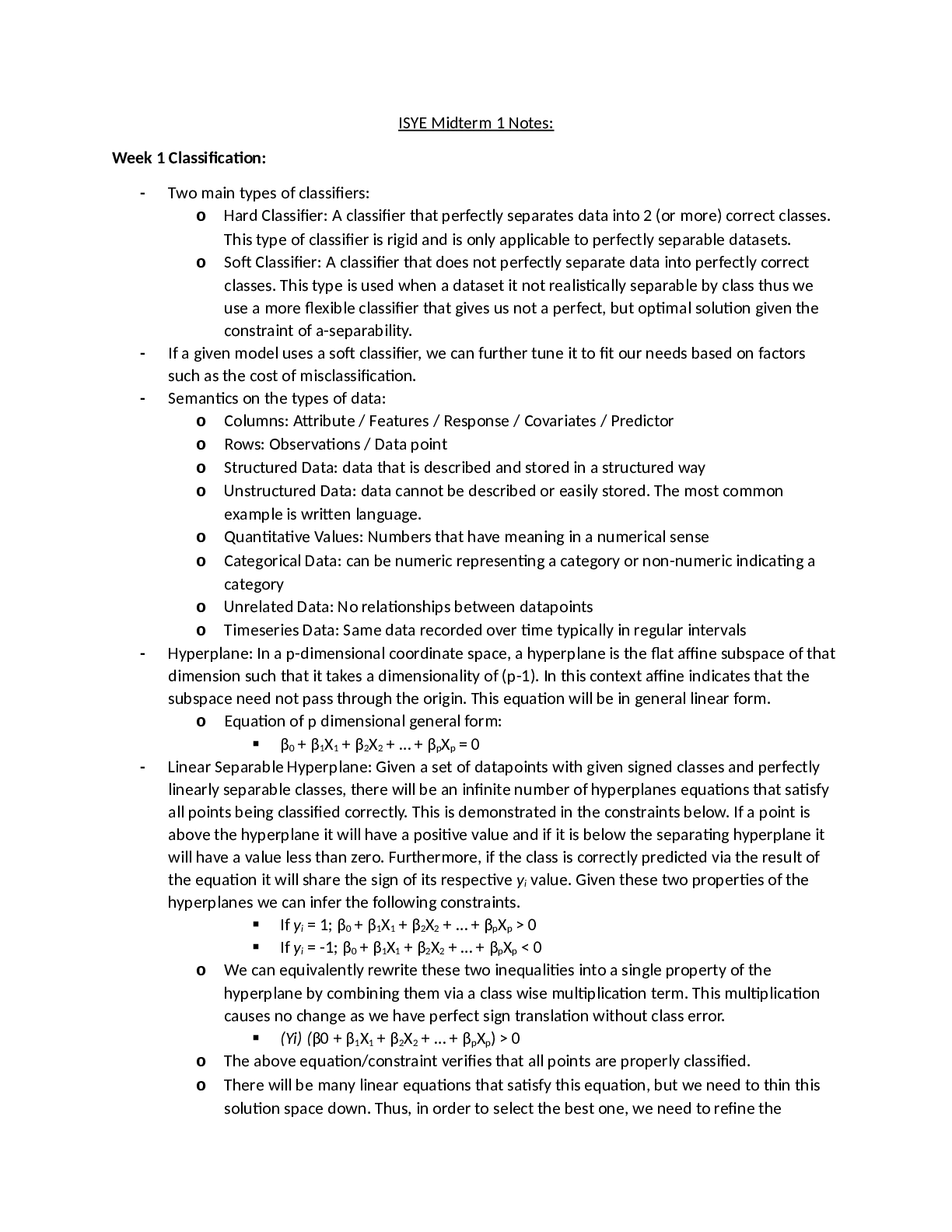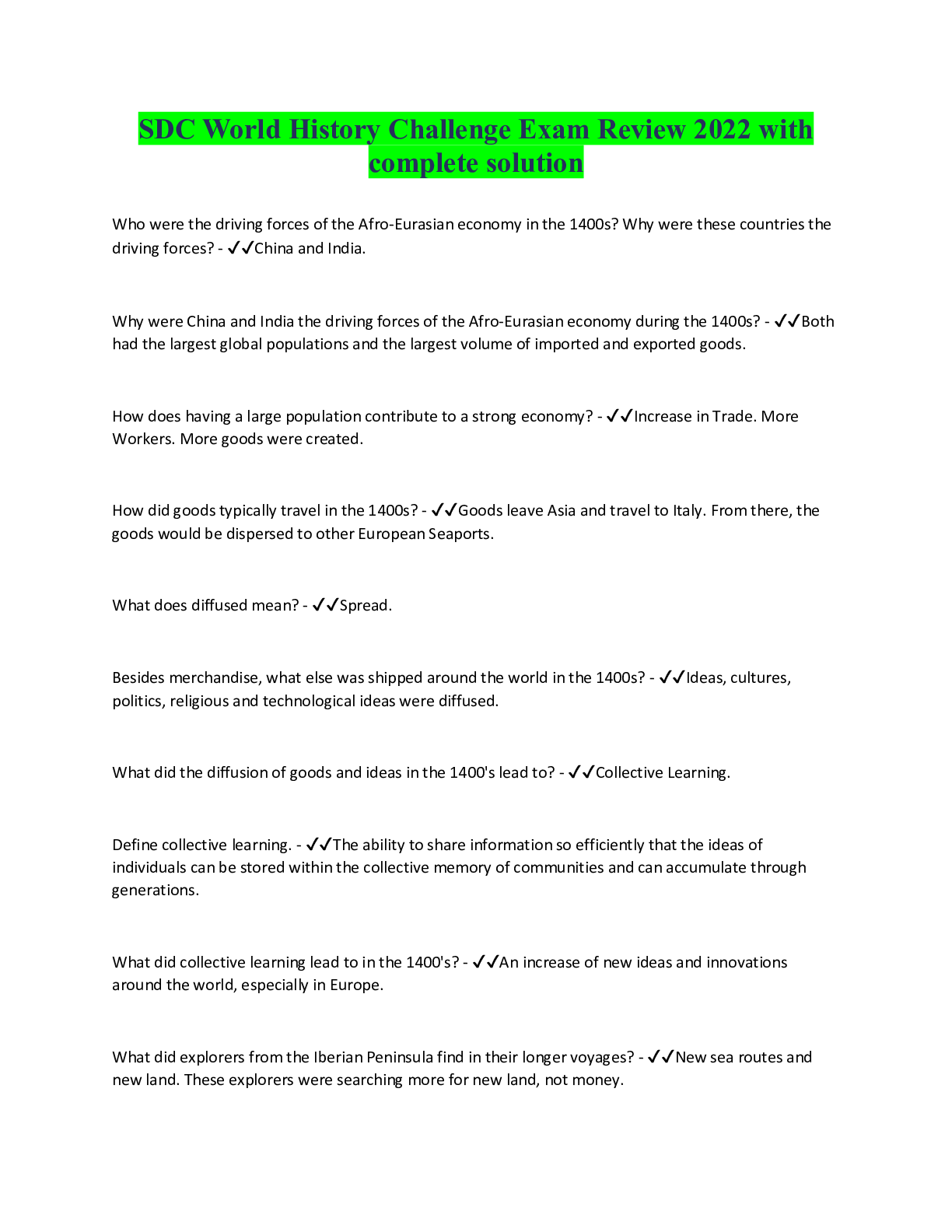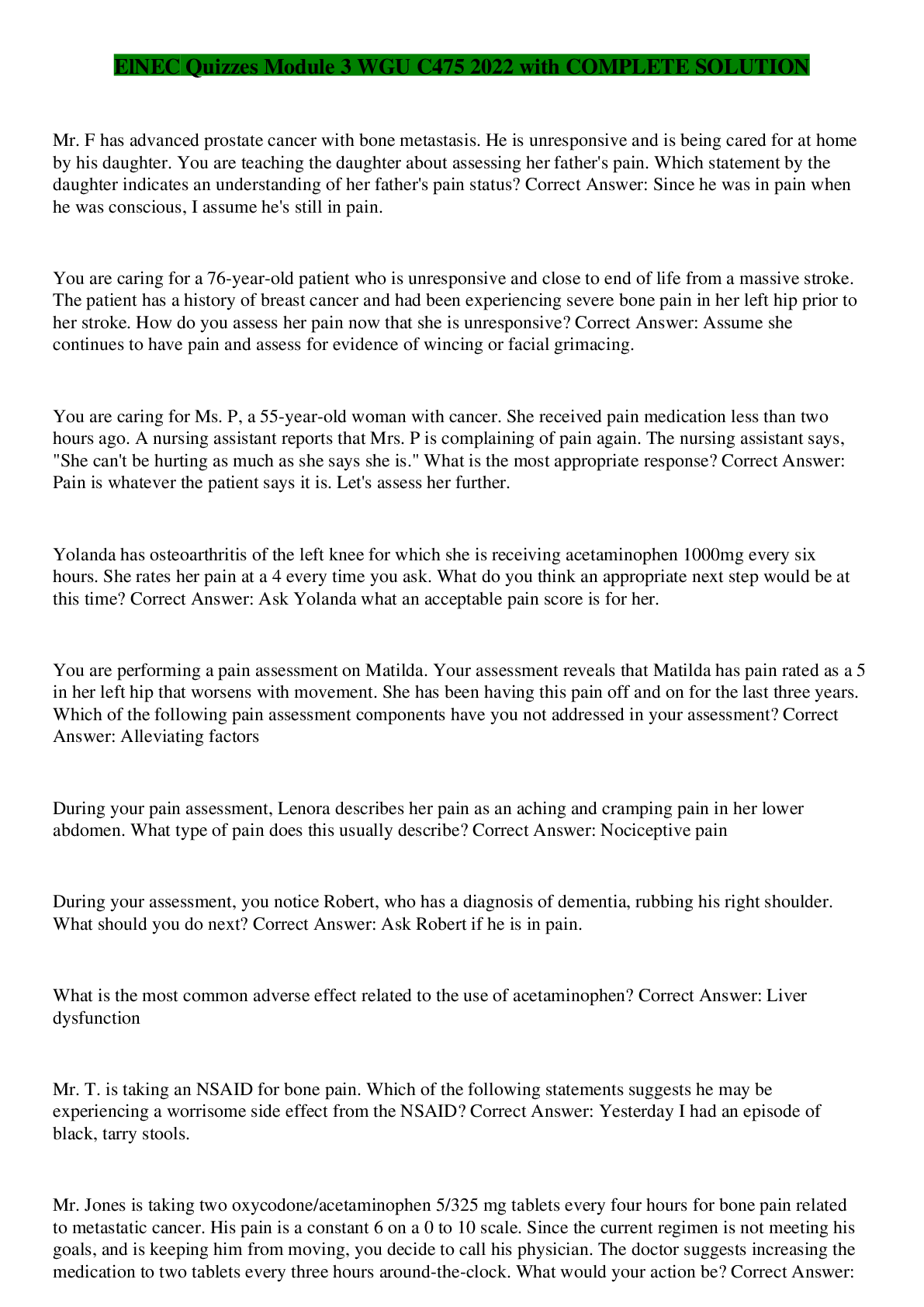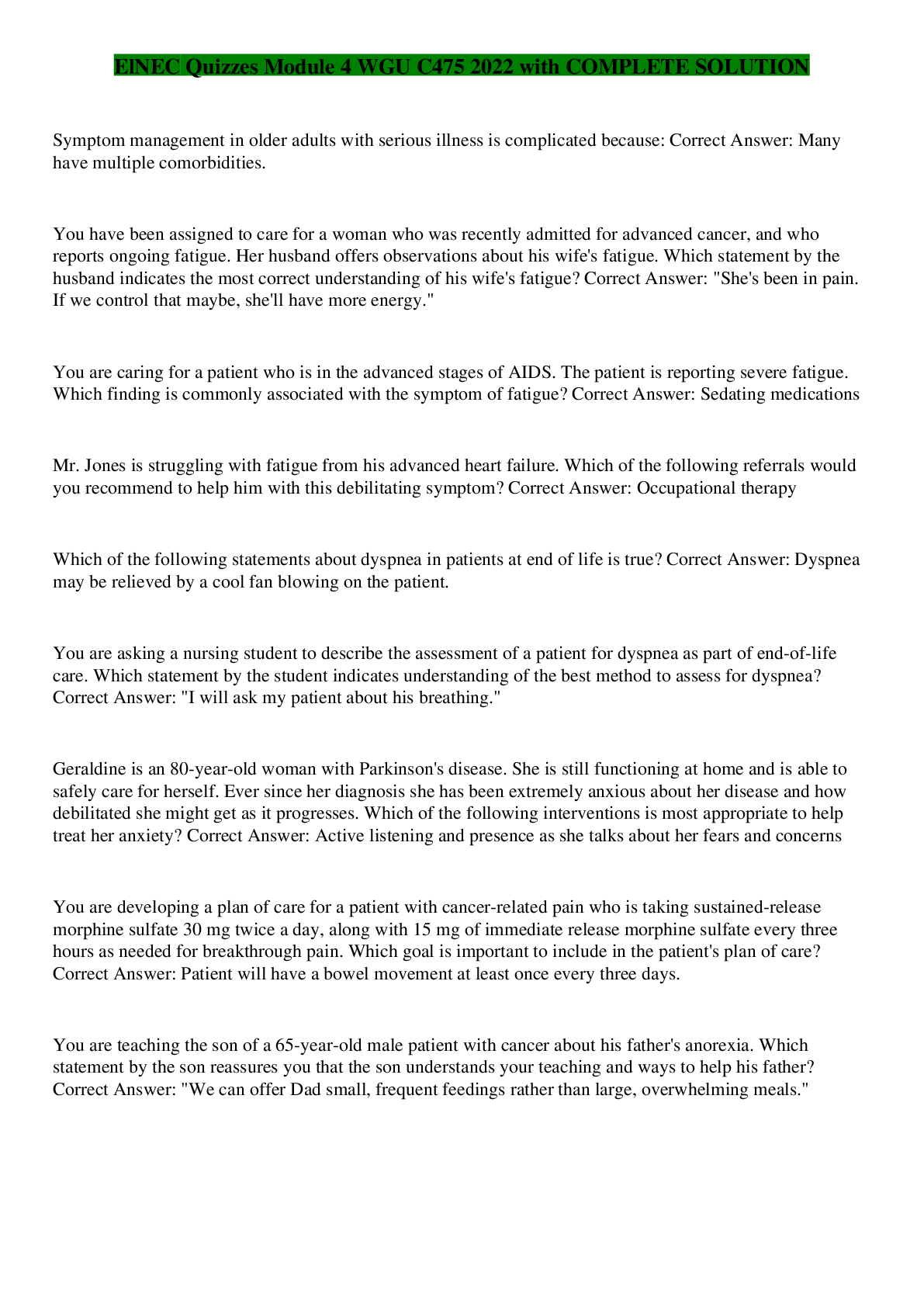Geography > QUESTIONS & ANSWERS > AP Human Geography Exam Review 2022 with complete solution. 100% proven pass rate. 2022/2023 (All)
AP Human Geography Exam Review 2022 with complete solution. 100% proven pass rate. 2022/2023
Document Content and Description Below
AP Human Geography Exam Review 2022 with complete solution absolute location - The exact position of an object or place, measured within the spatial coordinates of a grid system. cartography - sci... ence or art of making maps circular pattern - Objects that circle another object, another name for it is Centralized Pattern; For example, in an Islamic city, houses and public buildings may circle around the mosque, or house of worship. cultural landscapes - The products of complex interactions between humans and their environments. daylight savings time - the practice of temporarily advancing clocks during the summertime so that afternoons have more daylight and mornings have less distortion - a change in the shape, size, or position of a place when it is shown on a map environmental geography - The intersection between human and physical geography, which explores the spatial impacts humans have on the physical environment and vice versa. equator - an imaginary line drawn around the earth equally distant from both poles, dividing the earth into northern and southern hemispheres and constituting the parallel of latitude 0°. Eratosthenes - The head librarian at Alexandria during the third century B.C.; he was one of the first cartographers. Performed a remarkably accurate computation of the earth's circumference. He is also credited with coining the term "geography." formal regions - Also called uniform regions, an area that has striking similarities in terms of one or a few physical or cultural features. functional (nodal) regions - areas organized around cores, or nodes GIS - Geographic Information System; a computer system that captures, stores, analyzes, and displays data. globalization - Actions or processes that involve the entire world and result in making something worldwide in scope. Greenwich Mean Time - The time in that time zone ecompassing the Prime Meridian, or 0 degrees longitudeGPS - Global Positioning System; uses a system of satellites, tracking stations, and receivers to determine precise absolute locations on earth. grid pattern - Also called a rectilinear pattern, reflects a rectangular system of land survey adopted in much of the country under the Ordinance of 1785. Streets form grids and are sometimes labeled "1st", "2nd", "3rd" streets and so on. Hecataeus - Lived in the late 6th and early 5th centuries B.E.C., a Greek scientist, he wrote a book about geography and illustrated a map of the countries and inhabitants of the known world. human geography - a branch of geography that focuses on the study of patterns and processes that shape human interaction with the built environment, with particular reference to the causes and consequences of the spatial distribution of human activity on the Earth's surface Idrisi - An 11th century Arab geographer that worked for the king of Sicily to collect geographical information into a remarkably accurate representation of the world. Under his direction, an academy of geographers gathered maps and went out on their own scientific expeditions. Immanuel Kant - German philosopher and geographer in the 1700s that defined geography as the study of interrelated spatial patterns. landscapes - The overall appearance of an area that is shaped by both human and natural influences latitude - The numbering system used to indicate the location of parallels drawn on a globe and measuring distance north and south of the equator. linear pattern - when the pattern in along straight lines, like rivers, streets, or railroad tracks. local time - The standard time in the region that a person lives in location - The position of anything on Earth's surface. longitude - The numbering system used to indicate the location of meridians drawn on a globe and measuring distance east and west of the prime meridian (0°). George Perkins Marsh - An inventor, diplomat, politician, and scholar, his classic work, "Man and Nature, or Physical Geography as Modified by Human Action," provided the first description of the extent to which natural systems had been impacted by human actions.Mercator projection - a map projection of the earth onto a cylinder meridian - an arc drawn between North and South poles that measures longitude multi-national corporations - An example of economic globalization in which the business has centers of operation in many parts of the globe. parallel - A circle drawn around the globe parallel to the equator and at right angles to the meridians. pattern - the arrangement of objects on earth's surface in relation to other objects perceptual (vernacular) regions - places that people believe to exist as a part of their cultural identity periphery - the outer boundary of a region; Countries that usually have low levels of economic productivity, low per capita incomes, and generally low standards of living. The world economic periphery includes Africa (except for South Africa), parts of South America, and Asia. Peters Projection - An equal-area projection purposely centered on Africa in an attempt to treat all regions of Earth equally. place - A specific point on Earth distinguished by a particular character. physical geography - one of the two major divisions of systematic geography; the spatial analysis of the structure, processes, and location of the Earth's natural phenomena such as climate, soil, plants, animals, and topography. physical site characteristic - A location that includes climate, topography, soil, water sources, vegetation, and elevation. prime meridian - The meridian, designated at 0° longitude, which passes through the Royal Observatory at Greenwich, England. Ptolemy - a Greek scholar who lived five hundred years later than Eratosthenes, recalculated the circumference of the earth to be much smaller - by about 9000 miles. He was wrong, but his mistake was taken as truth for hundreds of years. Despite his famous miscalculations, his Guide to Geography included many rough maps of landmasses and bodies of water, and he developed a global grid system that was a forerunner to our modern system of latitude and longitude. random pattern - a pattern that exists if no regular distribution can be seen regionalization - the organization of earth's surface into distinct areas that are viewed as different from other areasRobinson projection - Projection that attempts to balance several possible projection errors. It does not maintain completely accurate area, shape, distance, or direction, but it minimizes errors in each. Carl Sauer - early 20th century geographer from California, shaped the field of Human Geography by arguing that cultural landscapes (products of interactions between humans and their environments) should be the main focus of geographic study. His study is basic to environmental geography, a field that centers on the interaction of human and physical geography. scale - The ratio between the size of an area on a map and the actual size of that same area on the earth's surface. site - the physical and human-transformed characteristics of a place situation - characteristic that refers to relative location solar time - based on the position of the sun in the sky as the day progresses space - the physical gap or distance between two objects space time compression - the reduction in the time it takes to diffuse something to a distant place, as a result of improved communications and transportation systems spatial organization - organization according to location, position, or direction spatial perspective - observing variations in geographic phenomena across space time zone - 24, 15 degree sections that each represent a different hour of the day topography - A description of surface features of land. toponym - Place names given to certain features on the land such as settlements, terrain features, and streams. U.S. Census Bureau - a principal agency of the U.S. Federal Statistical System responsible for producing data about the American people and economy. "why of where" - Critical to geographers, the explanations for why a spatial pattern occurs activity space - The space within which daily activity occurs. agricultural revolution - The time when human beings first domesticated plants and animals and no longer relied entirely on hunting and gatheringAIDS - Immune system disease caused by the Human Immunodeficiency Virus (HIV) which over a period of years weakens the capacity of the immune system to fight off infection so that weight loss and weakness set in and other afflictions such as cancer or pneumonia may hasten an infected person's demise arable land - land suitable for growing crops arithmetic growth - population growth where population increases by the same amount over each time interval arithmetic population density - The population of a country or region expressed as an average per unit area. The figure is derived by dividing the population of the areal unit by the number of square kilometers or miles that make up the unit awareness space - Locations or places about which an individual has knowledge even without visiting all of them, includes activity space and additional areas newly encountered or about which one acquires information. carrying capacity - Largest number of individuals of a population that a environment can support chain migration - migration of people to a specific location because relatives or members of the same nationality previously migrated there circulation - Short-term, repetitive, or cyclical movements that recur on a regular basis. critical distance - the distance beyond which cost, effort, and means strongly influence our willingness to travel crude birth rate - The number of live births per year per 1,000 people. crude death rate - The number of deaths per year per 1,000 people. demographic equation - The formula that calculates population change. The formula finds the increase (or decrease) in a population. The formula is found by doing births minus deaths plus (or minus) net migration. This is important because it helps to determine which stage in the demographic transition model a country is in. demographic momentum - this is the tendency for growing population to continue growing after a fertility decline because of their young age distribution. This is important because once this happens a country moves to a different stage in the demographic transition model. demographic transition theory - Multistage model, based on Western Europe's experience, of changes in population growth exhibited by countries undergoingindustrialization. High birth rates and death rates are followed by plunging death rates, producing a huge net population gain; this is followed by the convergence of birth rates and death rates at a low overall level demography - Scientific study of human populations. population density - A measurement of the number of persons per unit land area. dislocation - people forced from their home due to ethnic strife, war, or natural disasters distance decay - the effects of distance on interaction, generally the greater the distance the less interaction dot maps - Maps where one dot represents a certain number of a phenomenon, such as a population doubling rate - The length of time needed to double the population emigration - Migration from a location (Exit migration) endemic - Native or confined to a particular region or people epidemiologic transition - The shift from high death rates to low death rates in a population as a result of modern medical and sanitary developments. Also called the "mortality revolution" ethnicity - Identity with a group of people that share distinct physical and mental traits as a product of common heredity and cultural traditions. exponential growth - Growth whose rate becomes ever more rapid in proportion to the growing total number or size. Also called population growth at a "geometric rate" female infantcide - The preference to have a son is so extreme that it reduces the survival rate of baby girls forced migration - Human migration flows in which the movers have no choice but to relocate. gravity model - A mathematical formula that describes the level of interaction between two places, based on the size of their populations and their distance from each other. immigration - Movement of individuals into a population (In migration) Industrial Revolution - A series of improvements in industrial technology that transformed the process of manufacturing goods.infant mortality rate - The percentage of children who die before their first birthday within a particular area or country. in-migration - the total number of immigrants who arrive in a country in a given time period internal migration - Permanent Movement within a particular country. inter-regional migration - Permanent movement from one region of a country to another intervening obstacles - Any forces or factors that may limit human migration. intervening opportunity - the presence of a nearer opportunity that greatly diminishes the attractiveness of sites farther away. intra-regional migration - Permanent movement within one region of a country. life expectancy - A figure indicating how long, on average, a person may be expected to live linear growth - Expansion that increases by the same amount during each time interval. Thomas Malthus - Eighteenth-century English intellectual who warned that population growth threatened future generations because, in his view, population growth would always outstrip increases in agricultural production. migration - Form of relocation diffusion involving permanent move to a new location. migration selectivity - Only people exhibiting certain characteristics in a population choosing to migrate natural increase - Population growth measured as the excess of live births over deaths. Natural increase of a does not reflect either emigrant or immigrant movements. neo-Malthusians - group who built on Malthus' theory and suggested that people wouldn't just starve for lack of food, but would have wars about food and other scarce resources net-migration rate - Difference between immigrants and emmigrants per 1,000 people one child policy - A policy implemented by the Chinese government as a method of controlling the population. out-migration - the total number of immigrants who leave a country in a given time periodoverpopulation - The number of people in an area exceeds the capacity of the environment to support life at a decent standard of living. pandemic - Disease that occurs over a wide geographic area and affects a very high proportion of the population. physiological population density - The number of people per unit of area of arable land, which is land suitable for agriculture population concentrations - Areas of the world with large population density. population explosion - The rapid growth of the world's human population during the past century, attended by ever-shorter doubling times and accelerating rates of increase population geography - a division of human geography concerned with spatial variations in distribution, composition, growth, and movements of population. population pyramid - A model used in population geography to show the age and sex distribution of a particular population. pull factors - Factors that induce people to move to a new location. Also called "centripetal factors" push factors - Incentives for potential migrants to leave a place, such as a harsh climate, economic recession, or political turmoil. Also called "centrifugal factors" race - A group of human beings distinguished by physical traits, blood types, genetic code patterns or genetically inherited characteristics. Ernst Ravenstein - Created the laws of migration that state that most migrants move a short distance, move to an urban area, are adults, take the process in steps, and create a migration in the opposite direction refugees - People who are forced to migrate from their home country and cannot return for fear of persecution because of their race, religion, nationality, membership in a social group, or political opinion. restrictive population policies - laws which discourage or punish people for having large families. (anti-natal policies) space-time prism - The set of all points that can be reached by an individual given a maximum possible speed from a starting point in space-time and an ending point in space-time. spatial interaction - the movement of peoples, ideas, and commodities between different placesstationary population level - The level at which a national population ceases to grow step migration - Migration to a distant destination that occurs in stages, for example, from farm to nearby village and later to a town and city sustainability - The ability to keep in existence or maintain. A sustainable ecosystem is one that can be maintained total fertility rate - The average number of children born to a woman during her childbearing years. voluntary migration - movement in which people relocate in response to perceived opportunity; not forced. zero population growth - a condition in which the population of a country does not grow but remains stable. This condition comes about when the birth rate plus immigration equals the death rate plus emigration. acculturation - (n.) the modification of the social patterns, traits, or structures of one group or society by contact with those of another; the resultant blend animism - Belief that objects, such as plants and stones, or natural events, like thunderstorms and earthquakes, have a discrete spirit and conscious life. artifacts - object made by human beings, either hand-made or mass-produced assimilation - Adopting the traits of another culture. Often happens over time when one immigrates into a new country. Baha'i - Religion founded by Baha'ullah who declared himself as a prophet of God/"the promised one". Teachings: World peace through unity of all religions, live a simple life, dedication to serving others. behaviors - actions that people take beliefs - specific statements that people hold to be true, almost always based on values bilingualism - The ability to speak two languages Buddhism - A religion founded in India by Siddhartha Gautama which teaches that the most important thing in life is to reach peace by ending suffering. Confucianism - A philosophy that adheres to the teachings of the Chinese philosopher Confucius. It shows the way to ensure a stable government and an orderly society in the present world and stresses a moral code of conduct.contagious diffusion - The spread of a disease, an innovation, or cultural traits through direct contact with another person or another place. creole - a language that began as a pidgin language but was later adopted as the mother tongue by a people in a place of the mother tongue cultural determinism - the belief that the culture in which we are raised determines who we are at emotional and behavioral levels. This supports the theory that environmental influences dominate who we are instead of biologically inherited traits. cultural diffusion - The expansion and adoption of a cultural element, from its place of origin to a wider area. cultural ecology - The multiple interactions and relationships between a culture and the natural environment cultural geography - Subfield of human geography that looks at how culture varies over space cultural hearths - the areas where civilizations first began that radiated the customs, innovations, and ideologies that culturally transformed the world cultural landscape - the visible imprint of human activity and culture on the landscape. cultural relativism - The practice of trying to understand a culture on its own terms and to judge a culture by its own standards. cultural transmission - the process by which one generation passes culture to the next culture complex - a unique combination of culture traits for a particular culture group culture region - a portion of the earth's surface occupied by populations sharing recognizable and distinctive cultural characteristics culture system - sharing enough cultural traits and complexes to be recognized as a distinctive cultural entity culture trait - A single element of normal practice in a culture, such as the wearing of a turban Daoism - Chinese religion that believes the world is always changing and is devoid of absolute morality or meaning. They accept the world as they find it, avoid futile struggles, and deviate as little as possible from 'the way' or 'path' of nature.dialect - A regional variety of a language distinguished by vocabulary, spelling, and pronunciation. diasporas - Enclaves of ethnic groups settled outside of their homelands. Durkheim's sacred and profane - French sociologist Emile Durkheim, religion is important in explaining anything that surpasses the limits of our knowledge. As human beings, we define most objects as profane, or ordinary, but we define some things as sacred, or extraordinary, inspiring a sense of awe and reverence. Eastern Orthodox - The Christian religion of the Byzantine Empire in the middle east that formed from Christianity's schism between the remains of the western and eastern Roman Empire. The Christian church ruled by the Byzantine emperor and the patriarchs of various historically significant Christian centers/cities. environmental determinism - A doctrine that claims that cultural traits are formed and controlled by environmental conditions. ethnic religion - A religion with a relatively concentrated spatial distribution whose principles are likely to be based on the physical characteristics of the particular location in which its adherents are concentrated. ethnocentrism - Belief in the superiority of one's nation or ethnic group. extinct language - A language that was once used by people in daily activities but is no longer used. folk culture - Culture traditionally practiced by a small, homogeneous, rural group living in relative isolation from other groups. folk culture region - an area where many people who live in a land space share at least some traditions or customs folk life - the composite culture, both material and non-material, that shapes the lives of folk societies geographic region - a location based on locational and environmental circumstances as well as cultural properties. Torste Hagerstrand - Swedish geographer. He is known for his work on migration, cultural diffusion and time geography. hierarchical diffusion - the spread of a feature or trend from one key person or node of authority or power to other persons or placesHinduism - A religion and philosophy developed in ancient India, characterized by a belief in reincarnation and a supreme being who takes many forms humanism - A Renaissance intellectual movement in which thinkers studied classical texts and focused on human potential and achievements in which ideologies replaced religion as key cultural components. independent inventions - The term for a trait with many cultural hearths that developed independent of each other Indo-European language family - Language family including the Germanic and Romance languages that is spoken by 50% of the world's people Islam - A monotheistic religion based on the belief that there is one God, Allah, and that Muhammad was Allah's prophet. Islam is based in the ancient city of Mecca, Saudi Arabia, the birthplace of Muhammad. isogloss - A boundary that separates regions in which different language usages predominate. Judaism - A religion with a belief in one god. It originated with Abraham and the Hebrew people. Yahweh was responsible for the world and everything within it. They preserved their early history in the Old Testament. language - A system of communication through the use of speech, a collection of sounds understood by a group of people to have the same meaning. language families - Group of languages with a shared but fairly distant origin language sub-family - group of languages with more commonality than a language family (indicates they have branched off more recently in history) lingua franca - A language mutually understood and commonly used in trade by people who have different native languages. linguistic fragmentation - a condition in which many languages are spoken, each by a relatively small number of people linguistic geography - the study of the character and spatial pattern of dialects and language Mahayana - The name of the more mystical and larger of the two main Buddhist sects. This one originated in India in the 400s CE and gradually found its way north to the Silk road and into Central and East Asia.Marxism - the economic and political theories of Karl Marx and Friedrich Engels that hold that human actions and institutions are economically determined and that class struggle is needed to create historical change and that capitalism will untimately be superseded material culture - tangible, physical items produced and used by members of a specific culture group and reflective of their traditions, lifestyles, and technologies migrant diffusion - Where the spread of cultural traits is slow enough to weaken in the place of origin by the time it reaches other areas. monotheistic religion - Belief system in which one supreme being is revered as creator and arbiter of all that exists in the universe multilingualism - societies in which two or more languages are in common use non-material culture - Human creations, such as values, norms, knowledge, systems of government, language, and so on, that are not embodied in physical objects norms - rules and expectations by which a society guides the behavior of its members official langugae - A language given by the country to the government for laws, reports, public places, ad objects (like road signs, currency, stamps, etc.) pidgin - Language that may develop when two groups of people with different languages meet. The pidgin has some characteristics of each language. popular culture - general mass of people primarily urban based, constantly adopting, conforming to, and quickly abandoning ever-changing common modes of behavior and fads of material and nonmaterial culture Protestants - A Christian that separated from the Roman Catholic Church during the Reformation; today any member of the Christian church founded on the principles of the Reformation regional identity - An awareness of being a part of a group of people living in a culture region. Religious branches - large and basic division within a religion Religious denominations - divisions of branches that unite local groups in a single administrative body Religious sects - relatively small groups that do not affiliate with the more mainstream denominationsrelocation diffusion - the spread of an idea through physical movement of people from one place to another Roman Catholics - This branch of Christianity arose because of the Roman's split by Emperor Diocletian. shamanism - tribal religion; involves community acceptance of a shaman, religious leader, healer, and worker of magic who can intercede with the spirit world Shiite - a member of one of the two major Muslim sects; believe that the descendants of Muhammad's daughter and son-in-law, Ali, are the true Muslim leaders Sikhism - the doctrines of a monotheistic religion founded in northern India in the 16th century by Guru Nanak and combining elements of Hinduism and Islam standard language - The form of a language used for official government business, education, and mass communications. stimulus diffusion - The spread of an underlying principle, even though a specific characteristic is rejected. Sunni - "Traditionalists," the most popular branch of Islam; Sunnis believe in the legitimacy of the early caliphs, compared to the Shiite belief that only a descendant of Ali can lead. symbolic landscape - landscapes that express values, beliefs, and meanings of a particular culture. symbols - Anything that carries a particular meaning recognized by people who share a culture. syncretism - The unification or blending of opposing people, ideas, or practices, frequently in the realm of religion. For example, when Christianity was adopted by people in a new land, they often incorporate it into their existing culture and traditions. Tantrayana - a major branch in Buddhism; located mainly in western China (Tibet) and Mongolia. Theraveda - Traditional and conservative branch of Buddhism focusing on merit accumulation and sharin time-distance decay - The declining degree of acceptance of an idea or innovation with increasing time and distance from its point of origin or source toponymy - the study of place names of a region, or toponymstraditional religion - a religion that has originality and is not modernized, also known as "indigenous," "animism," "primal" or "tribal" transculturation - An equal exchange of traits or influence between two culture groups occurs universalizing religion - A religion that attempts to appeal to all people, not just those living in a particular location. Balkanization - The political term used when referring to the fragmentation or breakup of a region or country into smaller regions or countries. The term comes from the Balkan wars, where the country of Yugoslavia was broken up in to six countries between 1989 and 1992. binational or multinational state - State that contains more than one nation (example the Soviet Union) boundary - invisible line that marks the extent of a state's territ [Show More]
Last updated: 2 years ago
Preview 1 out of 33 pages

Buy this document to get the full access instantly
Instant Download Access after purchase
Buy NowInstant download
We Accept:

Reviews( 0 )
$10.00
Can't find what you want? Try our AI powered Search
Document information
Connected school, study & course
About the document
Uploaded On
Sep 21, 2022
Number of pages
33
Written in
Seller

Reviews Received
Additional information
This document has been written for:
Uploaded
Sep 21, 2022
Downloads
0
Views
134
























